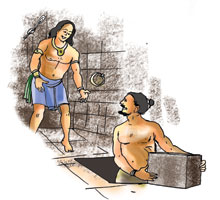The spies who were loyal to the Portuguese could not get any clue about this tunnel. It happened to be a remarkable one.
From miles away, it had
to be cut to lead exactly
to the prison cell. The
slightest mistake would have dashed all hopes. However, the work on the tunnel was completed to precision. One evening, a messenger went to meet Veediya Bandara. He asked Veediya Bandara to be very vigilant by midnight that day.
Just as planned, on that day – at midnight the people who were engaged in the task of cutting the
tunnel, came up in the
prison cell of Veediya Bandara. They paid him due respect by worshipping him. They did not want to delay one second.
They took Veediya Bandara and entered the tunnel in the dead of night. After a few hours, they came out of the tunnel.
They went to mansion of Veediya Bandara, which was in Raigama.
By this time, the queen Biso Bandara – who was none other than Suriyadevi was awaiting their arrival. No sooner she saw Veediya Bandara she welcomed him very warmly. That was a special happy day for everybody in his mansion. The cell of Veediya Bandara, the starting point of the tunnel, the distance it covered were all top secrets. It is a wonder that this task of cutting the tunnel could be kept such a top secret.
It is the Portuguese
writer Father Qyeros,
who had given all these
descriptions. But Father S. G. Perera, in his book ‘Ceylon History’ gives a
different version. According to him, the queen of
Veediya Bandara
somehow
managed to find a way to get her
husband out of prison. Her plan was successful, thanks to the help extended
by the Portuguese. During this period, the Portuguese were up to endless wrong doings.
The Sinhala
people had to
suffer as a result.
The few decent Portuguese
individuals, were
disgusted with the situation. They showed their loyalty to Veediya Bandara. Veediya Bandara’s wife, the queen, discussed matters with them and decided to cut the tunnel. The work on the tunnel was started on a land belonging to the Franciscan priests and this tunnel was to lead to the prison cell of Veediya Bandara.
They were able to
complete this task soon but secretly. Whatever the scholars say, the clever commander, who escaped from the hands of the Portuguese, got ready to fight again. Accompanied by the army that the queen had gathered, he marched towards Galle. There he destroyed a valuable ship, that was anchored at the Galle harbour. He set fire to it. Thereafter he proceeded to Raigam Korale.
He settled in a
village named Palanda. Within a short period of time, Commander Veediya Bandara had caused a lot
of damage.
A Jesuit priest had sent a full description of the damage caused by Veediya Bandara, to the authorities in Goa.
He had done so in the form of a letter dated December 15, 1552. In
this letter it was stated
that just a few people live
in Colombo and in Kotte where the king lives.
Most of the people had
fled to forest areas.
Through fear of Veediya Bandara, the people had given up their Christian faith. They had begun to embrace other religions. Numerous are the ruins of the houses that were burnt in Kotte. Anyone who witnessed this
disaster will be sad and angry. They are sure to hate him, and try to take revenge. The worst affected are the Christians.
|




